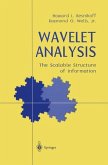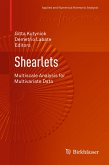Dieser Download kann aus rechtlichen Gründen nur mit Rechnungsadresse in A, B, BG, CY, CZ, D, DK, EW, E, FIN, F, GR, HR, H, IRL, I, LT, L, LR, M, NL, PL, P, R, S, SLO, SK ausgeliefert werden.
"This book can be recommended to everyone, especially to students looking for a detailed introduction to the subject." -Mathematical Reviews
"This textbook is an introduction to the mathematical theory of wavelet analysis at the level of advanced calculus. Some applications are described, but the main purpose of the book is to develop-using only tools from a first course in advanced calculus-a solid foundation in wavelet theory. It succeeds admirably. . . . Part I of the book contains 112 pages of preliminary material, consisting of four chapters on 'Functions and Convergence,' 'Fourier Series,' 'Fourier Transforms,' and 'Signals and Systems.' . . . This preliminary material is so well written that it could serve as an excellent supplement to a first course in advanced calculus. . . . The heart of the book is Part III: 'Orthonormal Wavelet bases.' This material has become the canonical portion of wavelet theory. Walnut does a first-rate job explaining the ideas here. . . . Ample references are supplied to aid the reader. . . . There are exercises at the end of each section, 170 in all, and they seem to be consistent with the level of the text. . . . To cover the whole book would require a year. An excellent one-semester course could be based on a selection of chapters from Parts II, III, and V." -SIAM Review
"D. Walnut's lovely book aims at the upper undergraduate level, and so it includesrelatively more preliminary material . . . than is typically the case in a graduate text. It goes from Haar systems to multiresolutions, and then the discrete wavelet transform . . . The applications to image compression are wonderful, and the best I have seen in books at this level. I also found the analysis of the best choice of basis, and wavelet packet, especially attractive. The later chapters include MATLAB codes. Highly recommended!" -Bulletin of the AMS









